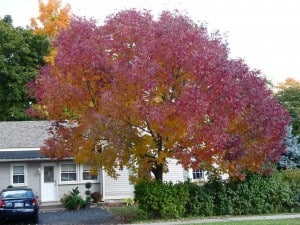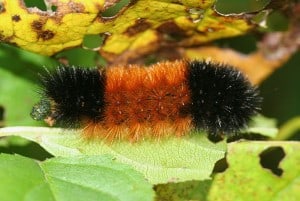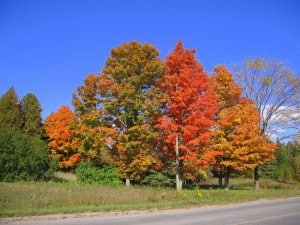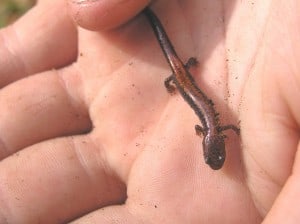Although fall’s official start is still almost three weeks away, a sense of the new season is already upon us. The blanket of goldenrod in fields and roadsides, the heavy morning mists and the hints of colour change in the leaves all tell us that summer is quickly waning.
As a reminder of what we can anticipate over the coming months, I have provided a list of the mileposts of fall’s progression. Right now, the long-term forecast is for cooler-than-normal conditions to kick off the fall season. Warmer weather, however, seems likely in early October, before temperatures drop in November.
SEPTEMBER
• Fall songbird migration is at its peak. Watch for warblers and vireos in trees and shrubs along forest edges and even in well-treed city backyards. Strangely enough, the key to their presence is often the sound of chickadees, which often join up with migrants during the day. A minute or two of pishing will quickly bring the chickadees out into the open with the warblers and vireos not far behind.
• The Harvest Moon, the full moon closest to the fall equinox, occurs September 8. For several evenings in a row, the moon rises at almost the same time and seems to linger on the horizon as it follows a shallow angle up into the sky. This year’s Harvest Moon qualifies as a “super moon” because of its closeness to Earth.
• Large mating swarms of ants are a common September phenomenon, especially on warm, humid afternoons. Some are females – the potential future queens – but the majority is males. Ants bear wings only during the mating season.
• The spiraling flight of pairs of white or sulphur butterflies is a commonly seen behaviour. A male and female butterfly will circle around each other, all the while ascending high into the sky. Then, without warning, the male will give up the chase and drop to the ground, almost like a dead weight. It is believed that the female initiates these aerial climbs to rid herself of unwanted suitors.
• The fall equinox takes place on September 22, marking the beginning of autumn. At the equinox, both the moon and sun rise due east and set due west. Day and night are of almost equal duration.
• Virginia Creeper turns a fiery red or deep burgundy. Poison Ivy offers up lovely oranges, while dogwoods and blackberry bushes provide beautiful burgundies.
• Two species of white-flowered vines are very much in evidence this month, especially along woodland edges where they sprawl over fences, shrubs and trees. They are Wild Cucumber, which develop into roundish, cucumber-like seed pods covered in soft bristles, and Virgin’s Bower, identified by its distinctive, fluffy seed heads of gray, silky plumes.
• Brown and black Woolly Bear caterpillars are a common sight on roads, sidewalks and trails. People used to believe (falsely) that the longer the middle brown band was, the shorter and milder the coming winter would be.
• Most years, White Ash, Pin Cherry and Staghorn Sumac reach their colour peak in late September. Some ash trees turn a stunning purple-bronze that literally glows in the September sun.
• By late September or the first week of October, the maples of the Canadian Shield and Algonquin Park are usually close to their colour peak. For an up-to-date fall colour report, go to www.ontariotravel.net
OCTOBER
• On an average year, fall colours in the Kawarthas reach their height at, or just before, Thanksgiving (October 13). For a great colour drive, go east from Apsley along County Road 504 through Lasswade and Glen Alda. Turn west at Glen Alda on County Road 604 to return to Highway 28.
• Sparrow migration takes centre stage this month making early October one of the busiest times of the year for backyard feeders. By scattering black oil sunflower seed or finch mix on the ground, you should be able to attract White-throated and White-crowned sparrows, along with Dark-eyed Juncos.
• As the goldenrods quickly fade away, asters dominate- and conclude -the wildflower parade for another year. The generally white flowers of heath and calico asters, along with the purple or mauve blossoms of New England and Purple-stemmed asters, seem to be everywhere. Go to ontariowildflowers.com for excellent tips on identifying asters.
• October is a great time to find salamanders. Red-backed Salamanders, which are almost worm-like in appearance, are usually the most common. However, you may also find both the Spotted and Blue-spotted Salamanders. Look carefully under flat rocks, old boards, and logs in damp wooded areas and around cottages.
• The signature constellation of fall is Pegasus and its asterism, the Great Square. Adjacent to the square is the Andromeda galaxy, our closest galactic neighbour. It appears through binoculars like a faint oval of fuzzy light – light that left the galaxy two million years ago! For detailed steps to finding this galaxy, go to Google and enter: wikihow Andromeda.
• Mid- through late October is very much a time of yellows. Most of the colour is being supplied courtesy of Trembling Aspen, Bigtooth Aspen, Balsam Poplar, Silver Maple, White Birch, and, at month’s end, Tamarack.
NOVEMBER
• Oaks, tamaracks and Silver Maples are about the only native deciduous trees that may retain their foliage in early November. Red Oaks stand out with particular prominence with their brownish-orange to sometimes burgundy-coloured leaves. At a glance, you are able to see just how common oaks are in many areas.
• We return to Standard Time on November 2 and turn our clocks back one hour. Sunrise on November 3 is at 6:53 AM and sunset at 5:00 PM for a total of only 10 hours and 7 minutes of daylight. This is one-third less daylight than the 15 and a half hours we enjoyed back in June!
• More collisions involving deer take place in late October and November than at any other time of year. When driving at dusk or after dark, watch for dark shadows along the side of the road and the bright green reflection of the deer’s eyes in your headlights. Slow down immediately. Deer are unpredictable when confronted with an automobile.
• The red berries of wetland species like Winterberry Holly and High-bush Cranberry provide some much needed November colour.
• Damp, decomposing leaves on the forest floor scent the November air. The smell of manure is often present, too, as farmers spread manure on their fields in the fall.
• With the onset of cold temperatures, Wood Frogs, Gray Treefrogs and Spring Peepers burrow down into the leaf litter of the forest floor and literally become small blocks of amphibian ice – in other words, a frogsicles! Surprisingly, the ice does not harm the animal because it forms in the body cavities outside of the cells. Glycerol, acting as an antifreeze, inhibits freezing within the frog’s cells.
• A trip to the Lakefield sewage lagoons is well worth the effort at this time of year. The lagoons are located on the south side of County Road 33, just south of the village off River Road. You should be able to get good looks at migrant ducks such as Common Goldeneye, Bufflehead, Ring-necked Duck, Lesser Scaup, and Hooded Merganser.
• Red-tailed Hawks, mainly from the boreal forest of northern Canada, migrate south into the United States. On a good day, hundreds can be seen flying along the north shore of Lake Ontario. Many central Ontario Red-tails are resident birds, however, and don’t migrate.
• Ball-like swellings known as galls are easy to see on the stems of goldenrod plants. If you open the gall with a knife, you will find the small, white larva of the Goldenrod Gall Fly inside. In the spring, it will emerge as an adult fly.
• The Pleiades (Seven Sisters) star cluster adorns the eastern sky, while Orion looms over the southeast. They both add interest to an evening’s walk in late November.



